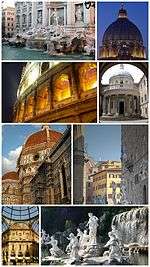Italian modern and contemporary architecture
| Architecture of Italy |
|---|
 |
| Periods and styles |
| Palaces and gardens |
| Notable works |
| Notable architects |
|
|
| By region |
|
| Other topics |
Italian modern and contemporary architecture refers to architecture in Italy during 20th and 21st centuries.
Styles
Beginning of 20th century
The Art Nouveau style was brought to Italy by figures such as Giuseppe Sommaruga and Ernesto Basile (who respectively designed the Palazzo Castiglioni and expanded the Palazzo Montecitorio in Rome). The ideas of this new style were published in 1914, in the Manifesto dell'Architettura Futurista (Manifesto of Futurist Architecture) of Antonio Sant'Elia. Rationalism found itself within the Gruppo 7 (1926), yet after the dissolution of the group, its distinguished figures Giuseppe Terragni (Casa del Fascio Como), Adalberto Libera (Villa Malaparte in Capri) and Giovanni Michelucci (Santa Maria Novella Station in Florence, in collaboration) appeared. During the Fascist period the so-called "Novecento movement" flourished, with figures such as Gio Ponti, Peter Aschieri, Giovanni Muzio. This movement was based on the rediscovery of imperial Rome. Marcello Piacentini, who was responsible for the urban transformations of several cities in Italy, and remembered for the disputed Via della Conciliazione in Rome, devised a form of "simplified Neoclassicism".
Fascism
The period of time following the end of World War II was marked by several architectural talents such as Luigi Moretti, Carlo Scarpa, Franco Albini, Giò Ponti, Tomaso Buzzi, amongst others; talents who indeed lacked a single direction. Pier Luigi Nervi, for example, with his bold and concrete structures, acquired an international reputation and was an influence to Riccardo Morandi and Sergio Musmeci. In a season inspired by interesting debates, brought forward by critics such as Bruno Zevi, rationalism prevailed, of which the Rome Termini Station can be said to be one of its paradigmatic works. The neorealism of Michelucci (designer of numerous churches in Tuscany), Charles Aymonino, Mario Ridolfi and others (neighborhoods INA-Casa) was followed by the Neoliberty style (seen in earlier works of Vittorio Gregotti) and Brutalist architecture (Torre Velasca in Milan group BBPR, a residential building via Piagentina in Florence, Leonardo Savioli and works by Giancarlo De Carlo).
Modernism
Carlo Scarpa accomplished significant modernist projects in the Veneto and Venice. Le Corbusier and Frank Lloyd Wright did not build anything in Italy, as opposed to Alvar Aalto (Church of the Assumption in Riola, Vergato), Kenzo Tange (towers of Bologna Fair, the floor of Naples central business district (CDN)) and Oscar Niemeyer (home of Mondadori in Segrate). The Postmodern style in architecture, anticipated by Paolo Portoghesi c. 1960, can be seen in the "Teatro del Mondo" (Theatre of the World) built by Aldo Rossi for the Venice Biennale of 1980.
Post-modernism
Among the principal architects working in Italy between the end of the 20th and the beginning of the 21st centuries were Renzo Piano (Stadio San Nicola in Bari, restructuring the Old Port of Genoa, Auditorium Parco della Musica in Rome, Padre Pio in San Giovanni Rotondo), Massimiliano Fuksas (skyscraper in the Piedmont Region, Convention Center in the EUR), Gae Aulenti (the Railway Museum of Naples underground), the Swiss Mario Botta (Museum of Modern and Contemporary Art of Trento and Rovereto, restructuring of the Teatro alla Scala in Milan), Zaha Hadid (National Museum of the 21st Century Arts in Rome, skyscraper "Lo Storto" in Milan), Richard Meier (Church of God Merciful Father and the casket of the Ara Pacis, in Rome), Norman Foster (Florence Station Belfiore), Daniel Libeskind ("Il Curvo" skyscraper in Milan) and Arata Isozaki (Palasport Olimpico in Turin, with Pier Paolo Maggiora and Marco Brizio, "Il Dritto" skyscraper in Milan).